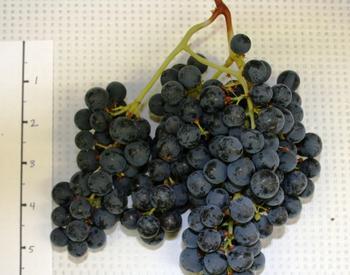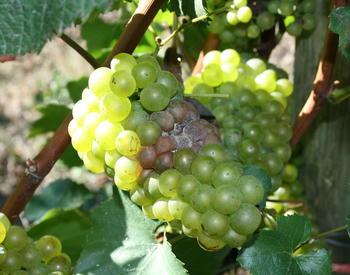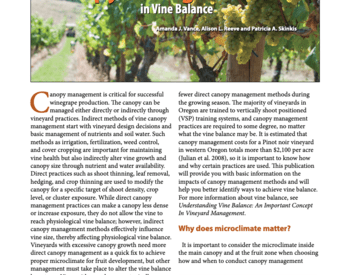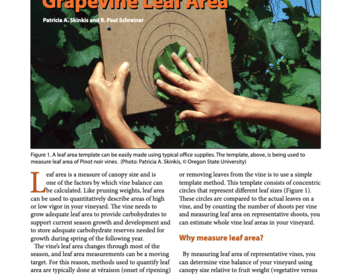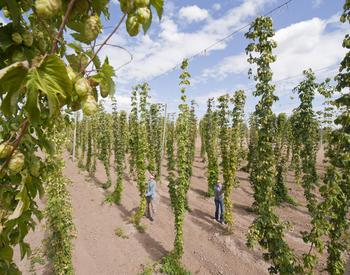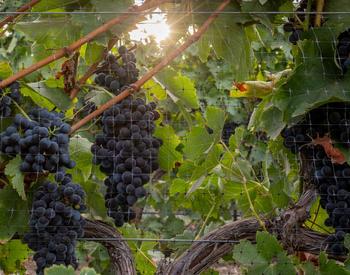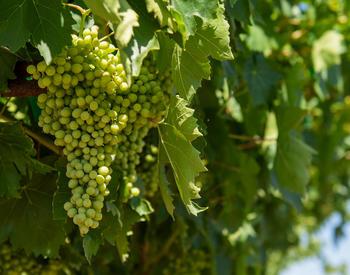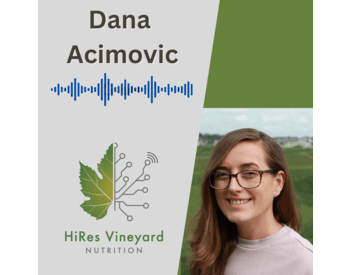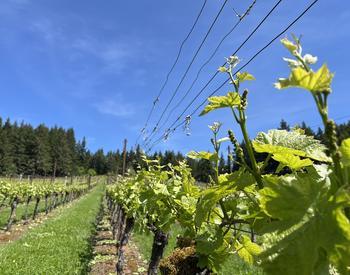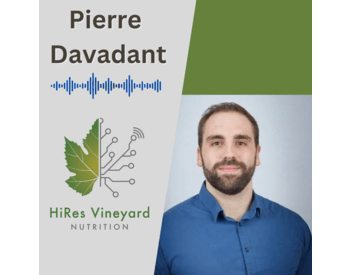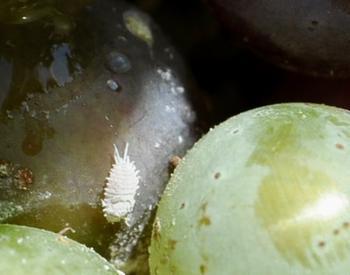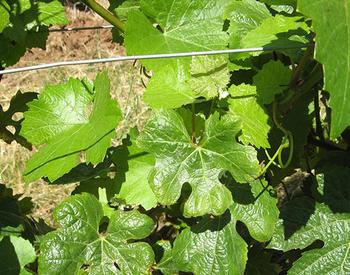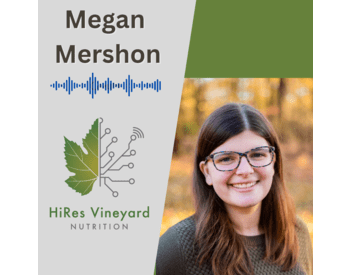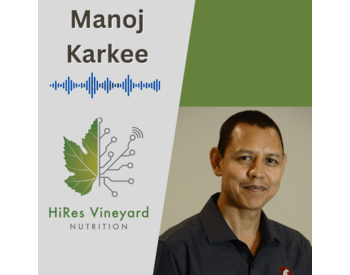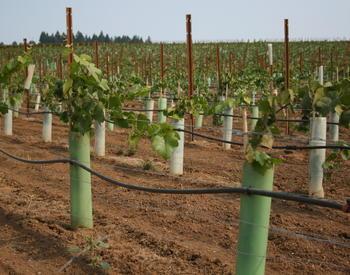Transcript
00:00 Patty Skinkis
This is the High-Res Vineyard Nutrition Podcast, devoted to helping the grape and wine industry understand more about how to monitor and manage vineyard health through grapevine nutrition research. I am your host, Dr. Patty Skinkis, Professor and Viticulture Extension Specialist at Oregon State University.
00:22 Patty Skinkis
Nitrogen is one of the most important mineral nutrients for plants and grapevines are no exception. The HiRes Vineyard Nutrition research team is focusing their research efforts on macronutrients, including nitrogen, phosphorus, and potassium or otherwise known as N, P, and K. We have projects being conducted across the US, but today we're going to be talking about nitrogen management research that's being conducted in eastern Washington. Eastern Washington is an arid region where both wine grapes and juice grapes are produced and there's a number of research projects that are looking at both, but Dr. Tom Groenveld, who's a [former] postdoc and project manager for the HiRes Vineyard Nutrition Project, is joining us to tell us a little bit about some of the research he's been involved with over the past few years in the Marcus Keller Lab at Washington State University (WSU). Thank you for joining us today, Tom.
01:13 Tom Groenveld
Hi, I am happy to be here; it is an honor to be here.
01:15 Patty Skinkis
As a project manager you had to split duties between trying to organize us all as a big national research group, but also to do research on the project in the Keller Lab. Can you tell us a little bit about your background and your research that you've done in agriculture before you came here to the project and to WSU? Can you tell us a little bit about the background before we jump into the research you've been involved with?
01:43 Tom Groenveld
I'm from Israel, and all the research I did was in the southern desert of Israel. Here [in Washington] is also considered a desert with eight inches of rainfall a year, but there is about one inch of rainfall a year on average in Israel, so there'll be years with none also, so it's a real desert. But [my work] was all with vegetables, growing different kinds of vegetables, so not with perennial plants. So, I learned a lot in my time here because the nutrient storage and stuff is much different because, you know of course, in vegetables you don't have that at all. Concerning the project management, that was actually something that some colleagues tried to scare me away from. They said, “Don't get into project management. You'll be stuck there being everybody's secretary and solving problems and organizing meetings.” But I was actually very pleasantly surprised when I came here because you know every group, every University does their [own] thing. I had to organize some meetings and make some connections between people, but most people know how to manage themselves, and so they don't require me too much for that.
02:48 Patty Skinkis
Well, that was great. That allowed you time to focus on an area of your training, which is working with plant physiology. I know you spent a good chunk of your time working on nitrogen management trials. Can you talk to us a little bit about the main research questions you were working on with nitrogen?
03:06 Tom Groenveld
Yeah, I can tell you the honest story--that'll be more interesting, I think. So, when I came here to do project management there wasn't actually a research project set up for me, which often happens when you come to a post-doc [position]. There'll be research that you're supposed to plug into. That wasn't the case for me, but I really liked that because it gave me the freedom to choose a topic. The limited budget, of course, I’d have to find money for that, but it gave the freedom in terms of the topic. So, the first thing I did when I got here was digging up vines out of the field to transfer them into pots of perlite. I did a lot of research on soil science and soil is super complicated, so I wanted to get that out of the equation. Of course, it's in the equation, a vineyard grows in the soil so you can't ignore it, but I was willing to look at nutrition and to eliminate some of the effects that soil can have on that. So, the first thing I did was dug up vines and put them in pots of perlite and that was in May or the beginning of June. The season had already started, but those plants survived, and they started growing and I started by looking into petiole sap to see if I could measure the nitrates in the in the petiole sap with a very cheap sensor that I could buy on Amazon, and to see if I could correlate that to what was in the root zone, which I was controlling because they [the vines] were in perlite. I could know exactly what's there and that didn't succeed. I just found no significant correlation. It’s kind of something that I wonder if somebody or several people already did before and just didn't publish because they didn't find a correlation because that's one of the hard things in science is when you fail--when you don't find a correlation--there's nothing really to publish. So that's what I did the first year and was a bit disappointed with that. But I had these great plants that were growing very good, so this last year I took those same nitrogen treatments, and I did a really interesting study looking at the effect of five nitrogen levels in the irrigation water, and then combining that with a high heat treatment. So, this area of Washington is already pretty hot in the summer, so I put half of the plants in an enclosed area. There was a plexiglass wall around it which prevented the heat from escaping so that area would be about almost 2°F hotter on average throughout the day. So that combined treatment was very interesting in looking, so I could measure how much nitrogen the plants were taking up over time because I was measuring how much I fertigated them. Fertigation is fertilizing in the irrigation water. So, how much nitrogen I was giving them and, I knew exactly how much was draining out the bottom of that pot, and so the difference would be the amount of nitrogen that the plant took up. So, I could know that I did that twice a week, so I'd know that on a bi-weekly basis throughout the whole season, which gave really interesting curves showing the exact nitrogen uptake over time for those different plants under different temperature conditions.
06:10 Patty Skinkis
So what age were these vines? How long were they in the field before you excavated them and repotted them?
06:18 Tom Groenveld
They were in the field for two years. They were just having fruit when I pulled them out. I removed the fruit when I pulled them out so that they would invest more into the leaves. So, they were in the field two years and in the pots for 2 years.
06:33 Patty Skinkis
What was the major finding that you found from doing this project adding nitrogen, five different levels, up to twice weekly? What were the things you looked at and what were the major findings at this point?
06:47 Tom Groenveld
So, I was looking at growth rate, transpiration, nitrogen uptake and then at the end of the season, the yield. I was keeping track of the different phenological stages of the vine to see if the high temperature or high nitrogen would affect those and then the yield quality parameters at the end of the season. There's still data coming in from the lab concerning the nitrogen distribution to different parts of the plant. What I was surprised by, again I didn't have a background in grapevines, but in what I had read people talked about the plant having a high nitrogen uptake around bloom time, so I was expecting there to be some kind of a peak, right? Because I was measuring how much it was taking up over time and there was no peak, the plant just took up nitrogen in a linear way, similar to its growth rate. The amount of growth was about equal to the amount of transpiration, and that was about relatively equal in terms of nitrogen uptake. There was no peak there. That surprised me because I was expecting it and I was actually doing more measurements at that bloom time, because I was expecting some changes to happen and that made a lot of work. But, the nitrogen uptake was linear throughout the season. Even after I removed the fruit at harvest, I kept growing the plants for another month until it got too cold and the uptake of the nitrogen, it just stayed linear, very similar to the transpiration. So that was surprising.
08:17 Patty Skinkis
So, I have one question around that. When you did your nitrogen applications, did you stop adding nitrogen at some point or was it consistently added throughout the lifecycle of those plants?
08:29 Tom Groenveld
Right - It's good that you ask because that's different in this experiment than the way it would be usually done. Because I'm from a vegetable background, I'm used to fertigating continually. When you fertigate continually you also get a steady state of what's in the root zone and the plant, and you can measure over time exactly what's being taken up. If I would just put fertilizer into the pot once or twice in the season like is often done and is also done in field applications, I wouldn't be able to know when the plant is taking up that nitrogen. So, by keeping the irrigation water at exactly the same concentration of nitrogen always and then always measuring the drainage water, I could know exactly what the plant was taking up over time. So yeah, it was continually fertilized throughout the whole season. The total amounts of fertilizer applied would be similar to other pot experiments, but it was just continually applied in order to be able to know that uptake over time.
09:23 Patty Skinkis
When you say you looked at uptake, were you doing destructive analysis of tissues or were you taking tissue samples along the way?
9:33 Tom Groenveld
So, in the end, at the end of the experiment in November I chopped up the plants, dried them all and measured all their dry biomass and everything, and I'm sending those samples to the lab to be measured destructively [for mineral nutrient concentrations]. So those plants are gone, they're destroyed. I was measuring the uptake over time by the mass balance that I was measuring on the plants. I measured exactly what I fertilized, so if I put in one liter of water for example on a given day and it would have 100 ppm of nitrogen in it, and then I'd measured the drainage and it'd have 50 ppm of nitrogen it, and it would be half a liter so then I'd measure I would multiply those and I'd have the amount of nitrogen coming in and nitrogen coming out. So, from that is what all the data I have till now is just from that mass balancing technique.
10:23 Patty Skinkis
Okay, that makes sense.
10:24 Tom Groenveld
Yeah, and I'll validate it. It comes to reasonable numbers if you compare it because there's no measurements of plants in that. But when I multiply the plant biomass that I have by an estimate of what should be there, it comes out to reasonable numbers. But, of course, I need to validate that still with the lab test by destructive sampling.
10:44 Patty Skinkis
So, the major finding was that nitrogen uptake was linear. There was never really a boost around that bloom time period, and we know that's in the context of continuously adding nitrogen. Do you think that results would have been a little bit different if you had say taken away nitrogen? I know this is in the context of a perlite system which means that there's no nutrients there. Can you speak to that a little bit?
11:10 Tom Groenveld
The plant--the vine--has its storage. It has nitrogen stored in it that it can make use of and so, you know, the plant didn't start taking up nitrogen from the system that I could measure until about two or three weeks into the experiment. I think about for 16 days I could start to see a difference between what I was putting in and what was coming out. So, in those first two weeks it was using up stored nitrogen that it had in the plant tissue. So, the plants are very flexible in that, and they can take up more nitrogen even when they don't need it and that was evidenced by the plants that were receiving an extremely high amount of nitrogen. They were still taking up continually throughout the season even though they were keeping nitrogen out. The concentration of the drainage water would be higher than the concentration of the irrigation water coming in, so they were actually taking up water to transpire and keeping the nitrogen out because they had too much but still they were taking up [more]. So yeah, the plants were taking up continually. If I would have stopped fertigating nitrogen, which I didn't do, I imagine the plant would have used up its storage nitrogen in that time until I started fertigating again. It would take up nitrogen. Again, they're very, very flexible. The point of doing this was to know what the plant can actually take up over time and how that would affect the plant because two of those nitrogen treatments were in excess. So, the plant was taking up all it could and there was more in the drainage than in irrigation water, so there was an excess of nitrogen for that plant. But the other treatments, they were in deficit, so the plant needed more nitrogen than I was giving it. So, it was taking up all the nitrogen. I would put nitrogen in the irrigation water and the drainage would be near zero, so it would take up all that it could, and the nitrogen was now limiting its growth. So, in the lowest treatment the plant stopped growing, stopped putting out leaves after about sixty days. After two months it stopped putting out new leaves. The terminal apex, where the leaves come out, wasn't dead, it was still alive, but it just wasn't growing more leaves. It was just starved for nitrogen, and it was putting it all into the fruit. That's actually what I found to be the most amazing thing is that these plants that were so nitrogen-starved kept transpiring, their transpiration of photosynthesis per leaf area was actually higher than the plants that received a lot of nitrogen which goes against everything that I've been reading. It's something that I've measured with the gas analyzer measuring photosynthesis on the leaf, but also on the mass balance, looking at the end of the season, chopping up the plant and seeing how much leaf area there is and how much biomass the plant gained. So that's very interesting that the plants are also very flexible in how they use their nitrogen over time, where they get it from, taking it up, storing it. But also, that nitrogen-deprived plants can still function in the same way as the plants that have plenty of nitrogen, which is very encouraging and which is probably the reason that we can fertilize so little nitrogen in vineyards, and in my opinion, could fertilize even less.
I'm wanting to look into the idea of managing vigor of the vine by means of nitrogen deficit. Here in eastern Washington, we manage vine size by giving a drought, water deficit, and that keeps the vine smaller. The vines are very sensitive to water stress; as soon as you stop irrigating, they'll stop growing. But in areas where it's very rainy or in areas, for example, here in our in our experimental block we have an area of the vineyard that's near an irrigation pond, and it's getting groundwater from below. So those vines look like monsters. They just keep growing, we can never stop them. But could we manage that vine size by nitrogen deficit? If we just stop fertilizing nitrogen that will limit the plant size. That's an interesting thing that I'd like to look into. It will affect, of course, the wine also, and that's maybe more of a philosophical concept, because that nitrogen needed in the wine, you can add that in the in the winery also. If you should or if you shouldn't, that's a whole different question that I don't know anything about. But in terms of vine vigor, it can be controlled also by nitrogen deficit.
15:50 Patty Skinkis
I think that's a really interesting concept because I think it really translates to those regions like you mentioned that aren't irrigated where we can't control our water, but we can manipulate nitrogen. We've done that in some of that work here in Oregon and western Oregon where we have plenty of soil moisture due to the rainfall, but we try to suck out nitrogen from the system by using grass cover crops for example. I know the folks in the eastern US have done that as well like in Justine Vanden Heuvel‘s Lab (Cornell) and Michela Centinari's Lab (Penn State) trying to use cover cups essentially to create that nitrogen deficit. We can't do it as easily as in the arid regions like you're dealing with, but this is very fascinating work to be able to get at that question of whether it's nitrogen or it's water. You know that's always the question we have with this research is: how much of the equation is nitrogen, how much of the equation is water, and do you think you're getting closer to at least a piece of the answer through this or this research?
16:53 Tom Groenveld
So yes and no. Yes, in terms of being able to measure the exact amount of nitrogen that the plant takes up over time in relation to its leaf area for example, or whatever parameter you want to relate it to. You can relate it to the plant size or to transpiration or anything and that would allow you to extrapolate it to the field condition. I see, for example, that at this amount of nitrogen uptake you'll get this leaf area size of the plant. So, there's a very strong correlation of the leaf area of the plant to exactly how much nitrogen it took up. So, in that, yes, and that can be very good for models describing plant growth and as a function of the amount of water available and amount of nitrogen available. But it's all in perlite because I took out the complexity of the soil and as soon as I stopped, you know exactly what's there. In the soil it's super complicated - there's the organic matter and there's the roots that are growing and then sloughing off and dying and decaying and becoming nitrogen again. There’s mycorrhizae, which I don't even know if I had that in my in my pot of perlite. It could be there, I don't know. But there's lots and lots of complexities taking place and then to recognize them amid other nutrient issues which can confound what you're looking for makes it very difficult. So yes, we're finding interesting relationships but it's in a very sterile system and to translate that to the field is complex. We want to do this in a field trial here in that area that I was telling you about where there's underground water coming into the vineyard. But to draw down the nitrogen in that block enough will take years because, how do you do that? You can flush out the nitrates, maybe, but you can't flush out organic matter and that's all the time mineralizing, all the time becoming available. It's very complex to implement it in the field.
18:57 Patty Skinkis
Yeah, this just shines light on the fact that to get some of the mechanistic answers we have to do projects in pots. But the translation [of the trial results] is not always direct. So, you mentioned the next steps about doing some field studies in those overgrown vines that have access to irrigation pond water. What type of studies do you think would be realistically done and what are the next steps for this work?
19:23 Tom Groenveld
So, what we're planning is to try to limit those vines. Sort of try to limit their vigor by a nitrogen deficit. And so, the nitrogen deficit would just be something that has to build up over time. Yeah, we have a cover crop there in that block and we'll probably need to add something else that takes up more nitrogen like a more vigorously growing cover crop. Maybe a deeper rooting cover crop that would take nitrogen, not something for a vineyard but specific. For example, corn, that's very deep rooting and has a high nitrogen use, just to try to get some of that nitrogen out of there. So, it'll take time to build up that nitrogen deficit. That's the plan, yes, to build up a nitrogen deficit and then to compare it with what we normally do here: managing vigor with irrigation.
20:18 Patty Skinkis
So, the broader applications of this work you had mentioned that you think growers could use less nitrogen. Can you talk a little bit about what you know about how growers are managing nitrogen, specifically in arid eastern Washington?
20:32 Tom Groenveld
I don't know much to be honest about how growers are managing nitrogen here. I know that it's applied as single, double applications, like one or two applications, which I was really shocked when I heard that. Again, coming from a horticulture, vegetable background I was like what? You apply for it and then it's all going to be to be leached out. There's denitrification taking place, there’s different places where that nitrogen is being. This study shed more light on it for me because I see that the vine is so good at ripening the fruit with a very low nitrogen level, which I saw in the experiment. Those were very low levels at the lowest treatment that I was giving. Still the fruit was ripe, and it had ripened earlier, the sugar levels were higher, just as the plant had stopped growing. It's very, very, very flexible, and robust in that, so I see I learned from that the timing of nitrogen fertilizing and the amount for the plant and for the crop doesn't seem so important. The issue here I think is more environmental concern. Because when we put down fertilizer, the plant will be fine and that's where the income is: from the yield and from the quality. But the timing can have big implications on what happens to the nitrogen that we put down and that's something that we don't pay for. It’s for free, there's no taxation on how efficient you are with nitrogen but that's an environmental concern. The nitrogen can be lost to drainage to the groundwater. It can be emitted as nitrous oxides which contribute to global greenhouse gases. There is a concern to limit nitrogen application even in a crop that is very nitrogen efficient and where, relative to other crops, we fertilize very little in grapevines. But still there is a concern to minimize that and so that's also why I'd be a proponent of, for example, adding that nitrogen that you might be missing in your fruit, the YAN, adding that in the winery. I’ve seen different studies that talk about different sensory, the different effects that that has on the quality of the wine. But I think if we understand and explain to people about the environmental concerns, that can also affect a lot about how we perceive the wine. In the end, what you think about what you're drinking affects a lot of how we perceive it to taste also.
23:12 Patty Skinkis
That's a great point. I know that there is some discussion out there amongst producers whether we put nitrogen in in the vineyard versus in in the winery, and that's a good point that I never considered before about the environmental impact. Just for the context of the listeners, the soil type you have in your region [eastern Washington] and why this is such a concern is because they have coarse soils. So the potential for nitrogen loss is high no matter what time of the year. The other question I want to know, because I'm sure listeners are wondering too, what cultivar are the grapes that you're using and are they own-rooted vines or grafted?
23:57 Tom Groenveld
It’s all Cabernet Sauvignon, and yeah, they’re own-rooted.
23:59 Patty Skinkis
Okay, great. So, this is a great project, and I think there's more that we're going to hear from this project in the future as we continue on the HiRes Vineyard Nutrition Project. I want to thank you for joining us today, but before we let you go, I have a fun question for you: What is the most interesting crop-plant that you've worked on or conducted research on?
24:23 Tom Groenveld
I worked mostly on cucumbers and bell peppers; that's not so interesting. I guess for a more local audience, it would be interesting that I worked on date palms. Date palms were interesting. Mango trees, trying to get mango trees to flower earlier, because that's kind of exotic here in Washington. I guess that would be the most interesting.
24:46 Patty Skinkis
Did you conduct research with date palms and mango trees or was it in production?
24:51 Tom Groenveld
Yeah, it was research. I was working as a technician for other researchers. It wasn't my research, but I got to set up the things, go up and measure how fast the middle frond on a date palm is growing with a measuring tape that's taped to the date palm. As the date palm grows it pulls that measuring tape up with it, so you just come there in the morning and record how much it grew every day. In mango trees we'd cover them with plastic hoop houses and then try to get them to flower earlier to get to an early market with a product, things like that. It wasn't my own research, but I was involved with it.
25:30 Patty Skinkis
So that brings up another question. So, you have experience in horticulture and experience in research. How did you find your way to horticulture and research in particular?
25:41 Tom Groenveld
Wow. I've been bouncing back and forth because when I left high school I never actually really wanted to study. I grew up in Africa, and I wanted to go back to Africa and drill boreholes. Because there's a lot of people that need a clean source of water, so I thought, “I'll go do that.” But when I met a guy in Africa that actually does that he says, “Well, we don't need anybody to come over here and work these rigs. Anybody here can do that. We need you to go and study then tell us where to drill the borehole.” So that's why I started studying. Water management studies turned into horticulture when I moved to Israel, and I left it to start growing my own vegetables and trying to sell them. I found out I can't make any money and that it's super hard work, and you have to do the same thing again and again as opposed to research where you can keep tinkering with things. So, I think that's what brought me back to research. I remember at that horticulture business that I had, I started to play with aquaponics, and I saw very clearly I was not going to make any money off of that, but it was super interesting and so I started a PhD just researching that. That’s what I love about research is that every time you can ask new questions, you can figure out new things. You don't have to do the same thing once you finish your project, you can continue that dig deeper or you could start something totally new and that's fascinating. There’s so much to discover and I really love that. So that's how I got into research and stayed in research eventually.
27:14 Patty Skinkis
Well, I agree. It's good to have that experience, both practical and scientific, bringing into the research projects. I like that perspective and getting to know a little bit about your history. That's fantastic, especially for those who are possibly looking into discerning their future career path. Well Tom, thanks for joining us today on this podcast. For those of you listening, thank you for joining. To learn more about the HiRes Vineyard Nutrition Project and maybe to see results of this project in the future, see our web site at https://highresvineyardnutrition.com/ and you can follow us on social media.
Did you ever wonder how much nitrogen grapevines take up and when? In this episode, Tom Groenveld, former project manager and post-doctoral scholar at Washington State University, describes a hydroponic nitrogen feeding study he conducted with Cabernet Sauvignon grapevines to address this question.
